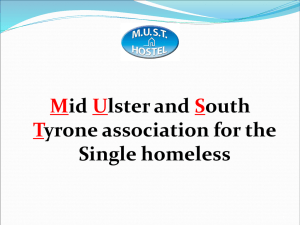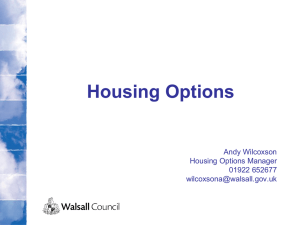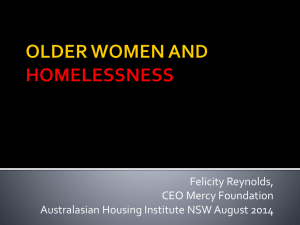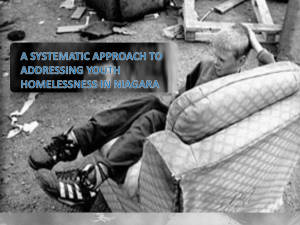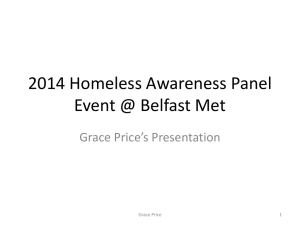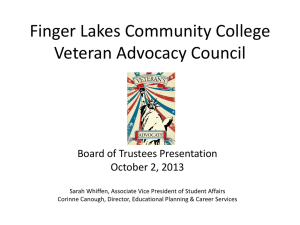Heading Home - Minnesota Coalition for the Homeless
advertisement
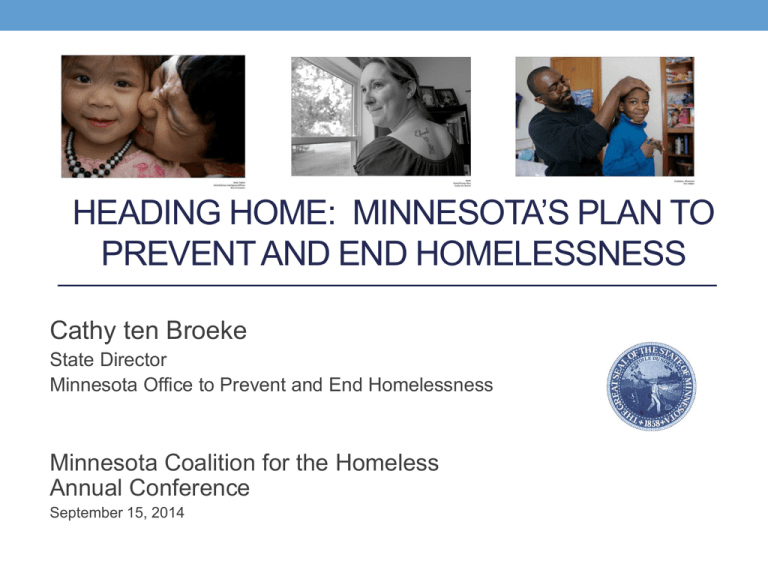
HEADING HOME: MINNESOTA’S PLAN TO PREVENT AND END HOMELESSNESS Cathy ten Broeke State Director Minnesota Office to Prevent and End Homelessness Minnesota Coalition for the Homeless Annual Conference September 15, 2014 Our Vision Housing Stability for All Minnesotans • Prevent and End Homelessness for Families with Children and Unaccompanied Youth by 2020 • Finish the Job of Ending Homelessness for Veterans and for People Experiencing Chronic Homelessness by 2015 12 Priority Focus Areas 23 strategies 100 specific action items Heading Home: Minnesota’s Plan to Prevent and End Homelessness www.headinghomeminnesota.org HEADING HOME MINNESOTA PROJECT MANAGEMENT UPDATE Amy Stetzel Project Manager Minnesota Interagency Council on Homelessness Minnesota Coalition for the Homeless Annual Conference September 15, 2014 Heading Home: Minnesota's Plan to Prevent and End Homelessness Project Management Update for all Actions in the Plan 12 Goals, 100 Actions, 11 Agencies, 80 staff Work is completed or started on 78% of all actions in the Plan 10%: Action is complete Work is completed or started on 100% of the actions due in 2014 (55 Actions are due in 2014) 18% (10) actions are completed 55% (30) actions have work well underway and are moving ahead 27% (15) actions have work started, but are moving slowly 22%: Work has not started due to action not being due 18%: Work has started, but is slow 50%: Work is well underway and moving ahead Work has begun on 43% of the actions due in 2015 (28 Actions are due in 2015) 43% (12) actions have work well underway and are moving ahead 57% (16) work has not begun due to action not being due Work has begun on 50% of the actions due in 2016 (4 Actions are due in 2016) 50% (2) actions have work well underway and are moving ahead Work has begun on 69% of the Ongoing Actions in the Plan (13 Actions are ongoing) 69% (9) actions have work well underway and are moving ahead ** Mapping the work of 3 other major state initiatives - Olmstead, Health Equity Initiative and the Children's Cabinet ** Incorporating and coordinating the work of 5 Federal grants into the work of the plan MINNESOTA’S PATH TO END VETERAN HOMELESSNESS Eric I. Grumdahl Special Advisor on Ending Veteran Homelessness Minnesota Office to Prevent and End Homelessness Minnesota Coalition for the Homeless Annual Conference September 15, 2014 HEADING HOME: Minnesota’s Plan to Prevent and End Homelessness BECAUSE WE ARE POISED TO END VETERANS HOMELESSNESS IN THIS STATE… • We will aggressively focus on finishing the job by ending homelessness for Veterans on a Veteran-by-Veteran basis. Collaboration between the VA and other homeless service providers will ensure that each Veteran experiencing homelessness has the tools they need to become stably housed. • FOR VETERANS, ending homelessness means there are fewer than 100 Veterans experiencing homelessness in Minnesota, or that Veterans make up no more than 1% of the total homeless population, whichever is less. Mayors Challenge to End Veteran Homelessness • Launched by First Lady Michelle Obama on June 4, 2014 • Over 200 Mayors, County Executives, and Governors participating to date • Intended to create opportunities for peer-topeer learning and marshal local efforts linked to Federal resources • Minnesota Governor Mark Dayton and seven Minnesota Mayors have joined Minnesota’s Path to End Veteran Homelessness Progress based on annual Point-in-Time count of Veterans experiencing homelessness 700 600 596 47% reduction 500 499 449 400 369 300 317 309 200 3.3x acceleration 100 0 39814 40179.25 40544.5 40909.75 Actuals Linear trend 41275 41640.25 Path to Zero 42005.5 42370.75 Key data points on Veteran homelessness Racial disparities in Minnesota homeless population, 2012 100 86 80 60 20 39 37 40 10 1 1 4 5 5 7 3 4 0 American Indian Asian American Black/African White/ Other/ American Caucasian Multiple % Homeless % Population Aging Cohort of Veterans Experiencing Homelessness (National) Hispanic (any race) Chronic and gender distribution for Veterans experiencing homelessness in Minnesota Wilder Survey 2012 7 46 54 93 Chronic Others Men Women Registry + Regional Strategies = Acceleration CVSO, outreach worker, shelter, etc. identifies a homeless Veteran Veteran is invited to join the Registry and sign a release of information Outreach and identification flow No Subsequent outreach may yield willingness of the Veteran to add identifying data Identifying entity calls or faxes LinkVet with anonymous record data Identifying entity calls or faxes LinkVet to update existing record with identifying data Yes Identifying entity calls or faxes LinkVet with known information for Registry entry Housing status changes identified since last run are conveyed to LinkVet Regional lists are regularly run against key data systems (HMIS, HOMES, etc.) to capture housing status changes LinkVet updates Registry with new information Veteran Registry Data system flow Case management flow Regional list Updates to Registry from team meeting are conveyed to LinkVet Regional team meets to assign unassigned Veterans and troubleshoot cases Field name REGISTRY_ID REGION_ID ROI_EXPIRATION FIRST_NAME MIDDLE_NAME LAST_NAME ALIASES ANONYMOUS_ID BIRTH_DATE LAST4_SSN BEST_CONTACT INTERVENTION HOUSEHOLD_SIZE VA_ELIGIBILITY VETERAN_STATUS OTHER_ELIGIBILITY INCOME HOUSING_STATUS REFERRAL_SOURCE CURRENT_PROVIDER NOTES Field description Unique record ID for each row Unique identifier for the region in which the Veteran is identified. Used for filtering the lists shared with regional teams. Date the Release of Information signed by the client expires. First name (if known) Middle name(s) (if known) Last name(s) (if known) Common delimited list of any known aliases used by the Veteran An anonymous ID established for any Veterans who opt not to sign a release of information form, based on outreach worker’s name and date of encounter. Veteran's date of birth, the the extent known Last four digits of the Veteran's Social Security Number Best contact method for engaging and reaching this Veteran Intervention needed, typically resulting from an assessment conducted by Coordinated Assessment process. Number of household members, used to determine housing unit size requirements. Pick-list of options for eligibility for VA homeless programs and health care. Confirmation of the Veteran's Veteran status and discharge by a qualified source. Comma-delimited list of codes designating eligibility: long-term homeless ("LTH"), chronic homeless ("CH"), mental health ("MH"), or substance abuse ("SA"). Could also include additional free-form notes about client eligibility. Estimated monthly income from all sources Current housing status, e.g, "Emergency shelter"; "Unsheltered / Outdoors"; "Transitional housing"; "Exiting a hospital or institution"; and "Housed" Name of the person and organization or entity that added this Veteran to the Registry. Useful for follow-up. Comma-delimited list of provider(s) working with the Veteran to secure housing. Notes field MAINSTREAM SYSTEMS REVIEW Cathy ten Broeke State Director Minnesota Office to Prevent and End Homelessness Minnesota Interagency Council on Homelessness Meeting September 4, 2014 Heading Home Priority Focus Area #4 Identify, assess and improve key mainstream programs by each state agency that could prevent and end homelessness for families and individuals How we Tackled the Goal External Opinion Research Nine initial programs selected for review Conducted interviews across the State 10 cross-cutting themes and 50 program-specific opportunities were identified Assessment of each theme and opportunity’s potential to impact homelessness and feasibility of implementation This External Opinion Research informed the: Development of Foundational Service Practices Developed using National Research, Current Federal and State Guidelines, and Program Subject Matter expertise Development of Priority Impact Areas Priority Impact Areas Promising Opportunities Foundational Service Practices “What’s hard for people who are housed is impossible for people who are homeless.” Foundational Service Practices 1) Know the housing status of the people you are serving 2) Actively reach out to people experiencing homelessness 3) Limit requirements for in-person appointments at a particular location or office 4) Assist with the process of gathering required verifications or documentation 5) Allow for multiple methods to communicate about benefits and services 2 Year Implementation Plan: Foundational Service Practices Year One Self-Assessment by Agency • Current Status – both across agency and delivery networks • Identification of Barriers and Opportunities for Improvement • Plans for Improvement Year Two and on Report out to the Interagency Council or the Senior Leadership Team on: Progress on Implementation of the 5 Foundational Service Standards How your Agency is Building on Successes and Improving Results Priority Impact Areas 3 Priority Impact Areas 5 Accompanying Recommendations Priority Impact Area #1: Advance a “first, get stably housed” policy. Recommendation A: Raise the MFIP grant and/or improve the way it is calculated Recommendation B: Support the Minnesota Family Investment Program (MFIP) Results Initiative and track whether parents served in results-focused counties are more likely to have housing-related activities and goals in their employment plans. The evaluators of the Results Initiative will explore whether helping parents address housing stability correlates with strong employment outcomes. Priority Impact Area #2: Stabilize childcare for children in families experiencing homelessness. Recommendation A: Authorize childcare benefits for knowable, stable periods of time. Reduce the “in-out” cycling in childcare because of parent activity fluctuations. Recommendation B: Increase access to early childhood scholarships for children ages 0-3 experiencing the crisis of homelessness. Increase dollars available and/or target children experiencing homelessness. Priority Impact Area #3: Seize Federal funding opportunities for employment services. As an Interagency Council, support the development of a bold Minnesota response to the $200 million dollar USDA SNAP E&T RFA that was just released to maximize access, continued connection, and impact for those SNAP recipients who are facing and already experiencing homelessness Contact Information • Cathy ten Broeke, Director, MN Office to Prevent and End Homelessness • cathy.tenbroeke@state.mn.us • Amy Stetzel, Project Manager, MN Office to Prevent and End Homelessness • amy.stetzel@state.mn.us • Eric Grumdahl, Special Advisor on Ending Veteran Homelessness, MN Office to Prevent and End Homelessness • eric.grumdahl@state.mn.us • Alison Niemi, Housing and Homelessness Policy Specialist, Minnesota Department of Human Services • alison.niemi@state.mn.us
